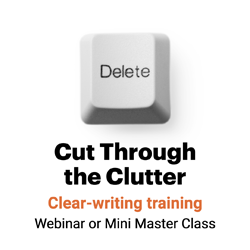Write about people doing things
Which of these headlines is most likely to spur you to sign up for a webinar?

New webinar helps managers improve productivity
Or:
Get all your work done in half the time, be the office hero and go home early
The first focuses on the webinar. But the second one focuses on me doing things. That makes the second one more compelling.
Want to watch your words get shorter, your sentences sleeker? See your passive voice disappear and your readability soar? Energize your writing? Populate it with real, live humans? Focus on benefits instead of features?
Use the active voice in writing. In other words, write about people doing things.
Why use the active voice in writing?
When you write about people doing things, you:
- Activate passive sentences. You know the difference between active and passive voice:
- In a sentence written in passive voice, the subject is acted upon by the object. Object verb subject.
- In a sentence written in active voice, the subject performs the action. Subject verb object.
- Improve readability. Writing in the passive voice also makes sentences and words longer and reduces readability. Take this passage:
- Children under 19
- Parents raising children under 19
- Pregnant women
- People 65 and older
- People with disabilities
That’s important: Writing in the active voice helps people read sentences faster, understand them more easily, remember them longer and enjoy the process more.
People doing things — Subject verb object — is the structure of the active voice. So turn passive-voice sentences into active-voice sentences by writing about people doing things:
No: Mortgage payments must be made …
Yes: Homeowners must make mortgage payments …
The subjects of these sentences are Medicaid, citizens and categories. Write about people doing things, and you make messages easy to read:
Yes: Are you eligible for Medicaid? That depends on who you are, how high your income is and how many other resources you have. The largest groups of people who qualify for Medicaid are:
The difference in readability between writing about Medicaid and writing about you? Sentences are 73% shorter; words, 111% shorter; and Flesch Reading Ease is up 192%.
How to use the active voice in writing
The Little Red Schoolhouse writing course recommends that you:
- Use the simple sentence structure: Subject verb object. Think of your sentences as short stories with clearly identifiable characters acting concretely.
No: Its failure could affect vehicle directional control, particularly during heavy brake application.
Yes: You won’t be able to steer when you put on the brakes.
- Make subjects humans. Write about people doing things, not about things doing things.
No: Growth occurred in Pinocchio’s nose when lies were told by him to Geppetto.
Yes: Pinocchio’s nose grew longer when he lied to Geppetto.
- Write in verbs, not nouns. Nix nominalizations, or words that turn verbs (like explain) into nouns (like explanation).
No: Our expectation was for a National Labor Relations Board (NLRB) ruling that management interference with the strike or harassment of picketing workers was not permitted.
OK, that one’s been through the De-Verb-O-Rizer a few times! Look at the verbs buried in those nouns: expectation, ruling, interference, harassment.
Don’t commit verbicide. Write about people doing things:
Yes: We expected the National Labor Relations Board (NLRB) to rule that management could not interfere with the strike or harass picketing workers.
Active voice in action
Wendy Jorgensen increased readability of this message by 40%, mostly by focusing on people doing things.
Here’s the City of Plano senior marketing and communication coordinator’s before:
[Subject: plan] Plano Tomorrow Draft Interactive Plan Launches
On April 3, [Subject: plan] the Plano Tomorrow comprehensive plan was launched online in draft form. [Subject: plan] The plan will be the guiding document for future development, transportation design, City service implementation and management of City parkland. [Subject: format] The web-based, interactive format of Plano Tomorrow is an emerging concept in cities around the world and is the first to be introduced by a Texas community. [Subject: plan] Historically, Plano’s comprehensive plan has been in a printed format that could only be accessed in person or downloaded online. [Subject: it (plan)] “In essence by doing the comprehensive plan in this format, it becomes a living document that can evolve as our population changes and new trends in development arise,” said Planning Director Christina Day. [Subject: you] Explore the 15 videos outlining aspects of the plan, watch as actions in the plan progress and rank the actions that matter most to you.
[Subject: plan] The plan was launched in advance of the Planning and Zoning Commission work session on Thursday, April 9 at 6 p.m. at Plano Municipal Center, 1520 K Ave. [Subject: session] The work session will focus on the draft Plano Tomorrow plan. [Subject: residents] Residents will be able to attend in person or to message questions through the City of Plano Facebook page or to post questions on Twitter with #PlanoTomorrow. [Subject: you] Check out the plan at planotomorrow.org.
Note that 70% of these sentences focus on things doing things, not on people doing things.
Here’s Wendy’s after:
[Subject: you] Make Your Community Stronger and Safer
[Subject: Tom Smith] Tom Smith takes the DART Rail every day to work. [Subject: Tom Smith] To get to the station, he walks 3 miles and some days the lack of sidewalks is challenging. [Subject: Tom Smith] He hopes to change that with Plano’s comprehensive plan.
[Subject: Tom Smith] He ranks sidewalks as a program he wants prioritized in the new Plano Tomorrow interactive.
[Subject: you] Put your mark on the plan to shape future growth and improve traffic delays and City services and parkland use. [Subject: rankings] Rankings are weighed during the annual budget process.
[Subject: you] Watch the Planning and Zoning Commission Plano Tomorrow work session on Thursday, April 9, at 6 p.m.:
- [Subject: you] Ask questions in person at Plano Municipal Center
- [Subject: you] Message us through the City of Plano Facebook
- [Subject: you] Post questions on Twitter (#PlanoTomorrow)
[Subject: you] Show us how you want your tax dollars invested at planotomorrow.org.
This time, 92% of the sentences focus on things doing things, not on people doing things. What a difference in readability that makes. By writing about people doing things, Wendy:
- Whittled word count by 13%.
- Slashed paragraph length by 68%.
- Streamlined sentences by 45%.
- Reduced syllables per word.
- Reduced Flesch-Kincaid Grade Level by 38%.
- Increased Flesch Reading Ease by 40%.
Want results like these for your own message? Use the active voice in writing. Write about people doing things.

Leave a Reply